Disc brakes are a critical safety component in your vehicle, demanding regular Disc Brakes Car Maintenance. Understanding how they work and maintaining them properly can significantly extend their lifespan and ensure optimal performance, preventing costly repairs and keeping you safe on the road. Let’s dive into the essential aspects of disc brake maintenance.
Understanding Your Disc Brake System
Your disc brake system uses hydraulic pressure to clamp brake pads against a rotor, slowing or stopping your wheel rotation. Key components include the rotor, brake pads, caliper, and brake fluid. The rotor is the metal disc that the brake pads clamp onto. The caliper houses the brake pads and pistons, which apply pressure. Brake fluid transmits the force from the brake pedal to the caliper. Each of these components plays a vital role in effective braking.
Why is Disc Brake Maintenance Important?
Regular disc brakes car maintenance is crucial for safety and performance. Neglecting it can lead to reduced braking efficiency, increased stopping distances, and even complete brake failure. Regular maintenance also helps prevent costly repairs down the line by addressing minor issues before they escalate into major problems.
Essential Disc Brakes Car Maintenance Tasks
Several key maintenance tasks are essential for keeping your disc brakes in optimal condition.
- Regular Inspections: Visually inspect your brake pads and rotors for wear and tear at least every six months or 10,000 miles. Look for thin brake pads, scored or warped rotors, and leaks in the brake lines.
- Brake Pad Replacement: Brake pads wear down over time and need to be replaced. How often depends on your driving habits and conditions. If your brake pads are getting thin or you hear a squealing sound when braking, it’s time for a replacement.
- Rotor Resurfacing or Replacement: Rotors can become warped or scored, reducing braking efficiency. Resurfacing can smooth out minor imperfections. However, if the rotors are too thin or severely damaged, they need to be replaced.
- Brake Fluid Flush: Brake fluid absorbs moisture over time, which can reduce its effectiveness. It’s recommended to flush your brake fluid every two years or as specified by your vehicle’s manufacturer.
- Caliper Inspection and Cleaning: The caliper can become sticky or seized, leading to uneven braking. Regular inspection and cleaning can prevent these issues.
 Inspecting Brake Pads and Rotors for Wear
Inspecting Brake Pads and Rotors for Wear
How to Check Your Brake Pads
Checking your brake pads is a simple process. Look through the spaces in your wheels to view the brake pads. You should be able to see the friction material on the pads. If they appear thin (less than 1/4 inch), it’s time for a replacement. You can also consult a professional mechanic for a thorough inspection. This is essential for maintaining optimal disc brakes car maintenance.
Signs of Disc Brake Problems
Recognizing the signs of disc brake problems is crucial for early intervention.
- Squealing or Grinding Noises: These sounds usually indicate worn brake pads.
- Vibration or Pulsation in the Brake Pedal: This often signifies warped rotors.
- Spongy or Soft Brake Pedal: A soft brake pedal can be a sign of air in the brake lines or low brake fluid.
- Pulling to One Side When Braking: This could indicate a seized caliper or uneven brake pad wear.
- Burning Smell: A burning smell after heavy braking can mean your brakes are overheating.
“Regular disc brakes car maintenance is not just about fixing problems; it’s about preventing them,” says John Davis, a seasoned automotive technician with over 20 years of experience. “A little preventative maintenance can save you a lot of headaches and expense in the long run.”
Extending the Life of Your Disc Brakes
Adopting good driving habits can significantly extend the lifespan of your disc brakes.
- Avoid Hard Braking: Anticipate stops and coast to a stop whenever possible.
- Maintain Proper Tire Pressure: Underinflated tires can increase the strain on your brakes.
- Reduce Vehicle Weight: Carrying excessive weight puts extra stress on the braking system.
“Investing in high-quality brake pads and rotors can also make a big difference,” adds Sarah Miller, a certified automotive engineer. “While they might cost a bit more upfront, they often last longer and provide better performance.”
Conclusion
Disc brakes car maintenance is crucial for ensuring your safety on the road. By understanding the key components of your disc brake system and following the recommended maintenance procedures, you can significantly extend the life of your brakes and prevent costly repairs. Regular inspections, timely replacements, and mindful driving habits are key to optimal disc brake performance. For professional assistance or further inquiries, connect with AutoTipPro at +1 (641) 206-8880 or visit our office at 500 N St Mary’s St, San Antonio, TX 78205, United States. We are here to help you keep your car in top condition.




Leave a Reply